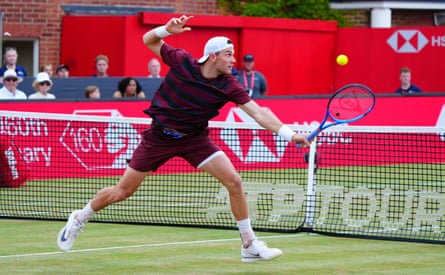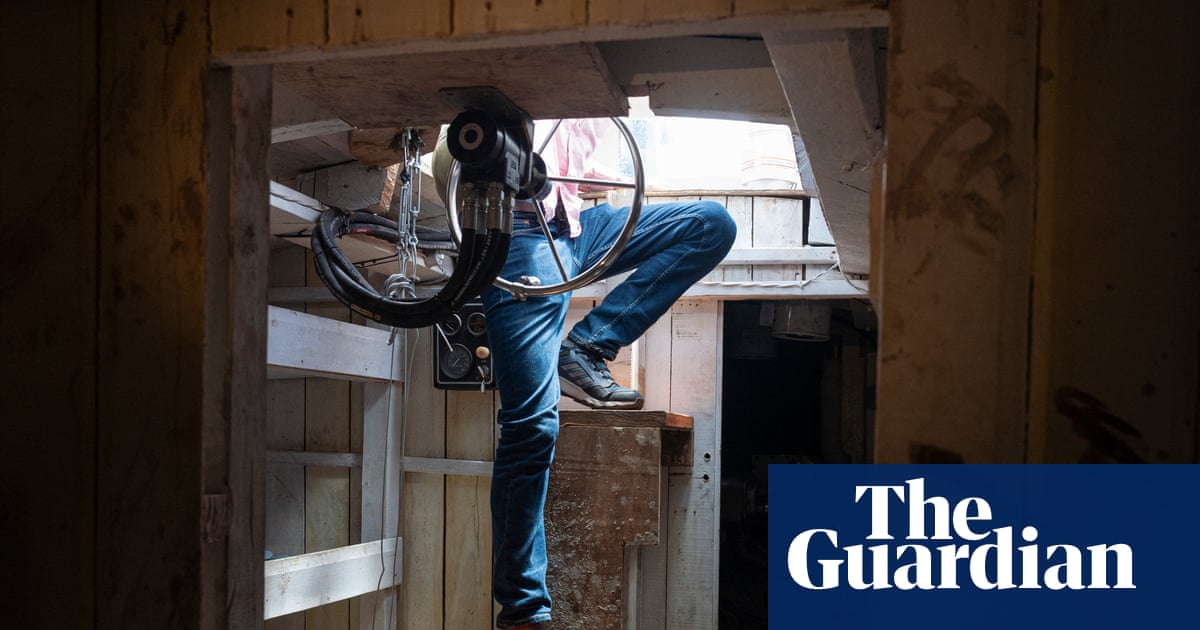Towards the end of 2018, a relatively unknown 16-year-old British tennis player took some of his first strides on the professional tennis circuit in a $15,000 (£11,000) tournament in Lagos, Nigeria on the ITF World Tennis Tour. Earlier that summer, Jack Draper had offered a glimpse into his considerable potential with a run to the Wimbledon boys’ final and his encouraging first tussles against adult opposition had earned him a modest ATP ranking of No 623. “I was very different then,” Draper says, smiling. “A bit of a maniac, to be honest.”
Those experiences were key in his development for various reasons. He ended that tournament by winning his third consecutive title, offering him more reason to believe he was on the right path. Along the way, he gained some essential perspective. “I’d have a wet [racket] grip, because it was so humid there. I’d put it in a bin and the kids were fighting over it. Just the energy from the people there, they were really passionate about tennis,” says Draper. “To go to those sorts of places was definitely … going from the UK and having a lot of, I guess, things given to me, it definitely helped the way I saw life.”
As Draper arrives at Wimbledon as the fourth best player in the world, and seeks out his first deep run at his home grand slam tournament, the 23-year-old’s disposition in his youth underlines just how far he has come. During his formative years, he was smaller than many contemporaries and his only route to victory was through grinding, scrapping and outsmarting his rivals. His teenage growth spurt was a transformative event in his career and he now stands at an imposing 1.93m (6ft 4in).
That dramatic physical change has allowed Draper to build one of the most well-rounded games on the tour. Although he is now a more offensive player, he has retained his excellent defensive skills from his youth. Draper’s wicked, varied lefty serve is one of his most pronounced strengths, even though its consistency is still a work in progress. While many big servers tend to not return as well, Draper is an even more effective returner.
His two-handed backhand was the foundation of his success during his youth, but he now looks to dominate with his heavy topspin forehand. He can still draw out errors from behind the baseline even though he has grown comfortable with attempting to dominate all opponents. Draper’s affinity for using drop shots and his comfort around the net also provide him with more options than most players to finish any given point.
“You’re scared of his forehand because he rips it cross, rips it down the line,” says the three-time grand slam finalist Casper Ruud. “You’re also, in a way, scared of his backhand because he can rip and counter from that side as well. So there aren’t many holes in his game that I see or that I feel.”

According to Tennis Viz, which uses data metrics to quantify the quality of strokes, Draper is the only player other than the world No 1, Jannik Sinner, to average a rating of more than eight (out of 10) for serve, return, forehand and backhand quality this year.
For Draper, being a complete player has been the goal all along. “When I was younger, I was always thinking: ‘If I’m going to be a top player, if I’m going to play someone, what do I want them to think?’” says Draper. “And I want them to think: ‘He has no weaknesses,’ because I know that if I play someone who has no weaknesses, I’d be feeling a lot of pressure. So I suppose that’s the goal I want to get to. I’m still not fully there, but I’m wanting to get to that.”
Of all the shots in his arsenal, Draper’s forehand has changed and improved more than anything else. A natural right-hander, his two-handed backhand has always been his most instinctive and reliable groundstroke. When they began working together in 2021, Draper and his coach, James Trotman, spent significant time discussing how to improve his forehand.
“The forehand was an area that I always thought could be a weapon, but it was a weakness as well,” he says. “Any time anyone would rush it, it would not hold up. I wasn’t able to get through the ball as much as I wanted to. We worked on my body positions, how I’m going to be able to come forward. There’s a big misconception that to be a top player your forehand has to look a certain way. I don’t think that’s the truth. You just have to hit the ball in front and learn how to use your body to be effective.”
While his forehand is still a work in progress, it has been a decisive factor in his recent success. He has long possessed one of the heaviest forehands in the game, with the stroke averaging 3,158 revolutions per minute (rpm) over the past year, far above the tour average of 2,844rpm, but this year he has been determined to flatten the stroke out, look to dominate opponents with it and attack more frequently down the line. His forehand quality has increased from 7.6 to 7.9, elevating it from 25th on the tour last year to 14th in 2025.
after newsletter promotion
Possessing such a varied skill set is clearly an asset to any player, but for a long time Draper still could not find his identity on the court. Last year, as he still struggled to shake off his defensive instincts, Draper hired the former top 10 player Wayne Ferreira as a supplementary coach alongside Trotman. After years of being instructed to play the brand of ultra-offensive tennis befitting a big man, he tried it out.

“I was in a bit of a crisis last year thinking: ‘Where’s my game going to go? What do I need to change?’” Draper says. “Then I did certain things and I tried to maybe go to the opposite end of the spectrum and try and hit every ball as hard as I can, and return up the court and do all these things, but it didn’t really work, that experiment.”
Although he won his first ATP title in Stuttgart during this period, Draper suffered a first-round loss at the French Open followed by a miserable second-round defeat at Wimbledon by Cameron Norrie. By the end of the summer, the experiment was over. The experience taught him that he could find a greater balance between attack and defence in his game, but also a fundamental lesson that he will never forget: he should always trust himself.
“It got to the point where maybe I was thinking that I needed to do something drastic to be a top player,” he says. “The truth was I just needed to be consistent, trust the work that I was doing, and know that with the right mentality and doing things well day in, day out and preparing the best I can for competitions, that’s going to just help me to find more consistency and be the top player I wanted to be. So it feels good to have gone on that journey and realised that it’s just hard work, really.”

 2 months ago
45
2 months ago
45

















































